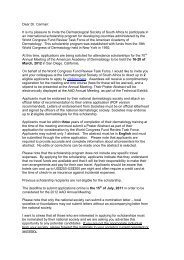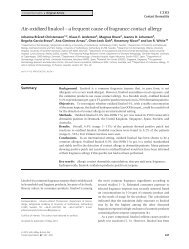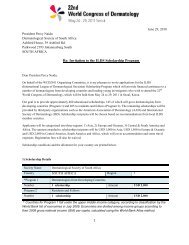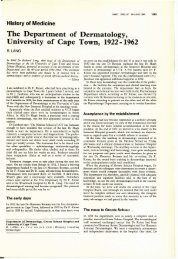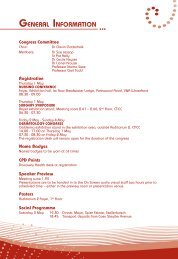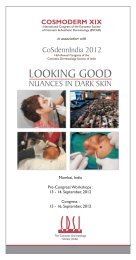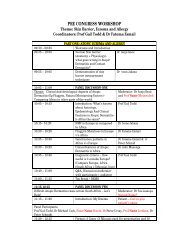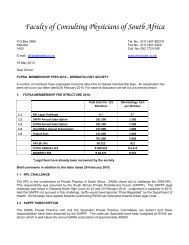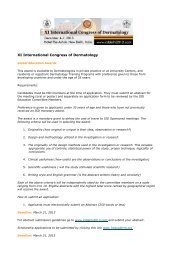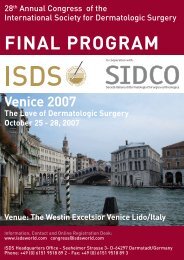Guidelines on the Management of Atopic Dermatitis ... - Dermatology
Guidelines on the Management of Atopic Dermatitis ... - Dermatology
Guidelines on the Management of Atopic Dermatitis ... - Dermatology
Create successful ePaper yourself
Turn your PDF publications into a flip-book with our unique Google optimized e-Paper software.
20. Muzaffar F, Hussain I, Rani Z, et al. Emollients as an adjunct <strong>the</strong>rapy to topical corticosteroids<br />
in children with mild to moderate atopic dermatitis. J Pakistan Assoc Dermatologists<br />
2002;12:64-8<br />
21. Cork MJ. Complete Emollient Therapy. The Nati<strong>on</strong>al Associati<strong>on</strong> <strong>of</strong> Fundholding Practice<br />
Official Yearbook. L<strong>on</strong>d<strong>on</strong>: Scorpio; 1998. p. 159-68<br />
22. Grimalt R, Mengeaud V, Cambazard F, et al. The steroid-sparing effect <strong>of</strong> an emollient <strong>the</strong>rapy<br />
in infants with atopic dermatitis: a randomized c<strong>on</strong>trolled study. Dermatol 2007;214(1):61-7.<br />
23. Hindley D, Galloway G, Murray J, et al. A randomised study <strong>of</strong> “wet wraps” versus c<strong>on</strong>venti<strong>on</strong>al<br />
treatment for atopic eczema. Arch Dis Childhood 2006;91(2):164-8<br />
24. Schnopp C, Holtmann C, Stock S, et al. Topical steroids under wet-wrap dressings in atopic<br />
dermatitis – a vehicle-c<strong>on</strong>trolled trial. Dermatol 2002;204(1):56-9<br />
25. Chamlin SL, Kao J, Frieden IJ, et al. Ceramide-dominant barrier repair lipids alleviate childhood<br />
atopic dermatitis: changes in barrier functi<strong>on</strong> provide a sensitive indicator <strong>of</strong> disease activity. J<br />
Am Acad Dermatol 2002;47(2):198-208<br />
26. Simps<strong>on</strong> E, Dutr<strong>on</strong>c Y. A New Body Moisturiser Increases Skin Hydrati<strong>on</strong> and Improves <strong>Atopic</strong><br />
<strong>Dermatitis</strong> Symptoms am<strong>on</strong>g Children and Adults. J Drugs Dermatol 2011;10(7):744-9<br />
27. Danby S.G, Al-Enezi T, Sultan A, Chittock J, Kennedy K, Cork M.J. The effect <strong>of</strong> aqueous<br />
cream BP <strong>on</strong> <strong>the</strong> skin barrier in volunteers with a previous history <strong>of</strong> atopic dermatitis. Br J<br />
Dermatol 2011;165:329–34<br />
28. <strong>Atopic</strong> eczema in children: management in children from birth up to <strong>the</strong> age <strong>of</strong> 12 years Clinical<br />
Guideline NICE December 2007<br />
Topical pharmacological treatment <strong>of</strong> atopic dermatitis<br />
Topical corticosteroids (TCS) [1++; A]<br />
Topical corticosteroids c<strong>on</strong>tinue to be <strong>the</strong> mainstay <strong>of</strong> atopic dermatitis treatment. 1,2 For<br />
more than four decades TCSs have provided effective flare c<strong>on</strong>trol through <strong>the</strong>ir antiinflammatory,<br />
antiproliferative, immunosuppressive, and vasoc<strong>on</strong>strictive acti<strong>on</strong>s. 3 They<br />
suppress <strong>the</strong> release <strong>of</strong> inflammatory cytokines, and <strong>the</strong>y act <strong>on</strong> a variety <strong>of</strong> immune cells,<br />
including T lymphocytes, m<strong>on</strong>ocytes, macrophages, dendritic cells and <strong>the</strong>ir<br />
precursors. 4 Various strengths and formulati<strong>on</strong>s <strong>of</strong> TCS are available. The extent to which<br />
<strong>the</strong>y induce cutaneous vasoc<strong>on</strong>stricti<strong>on</strong> and inhibit inflammati<strong>on</strong> corresp<strong>on</strong>ds with <strong>the</strong>ir<br />
potency. There are no adequate trials to suggest superiority <strong>of</strong> <strong>on</strong>e corticosteroid within a<br />
potency group over ano<strong>the</strong>r.<br />
The extensive use <strong>of</strong> topical corticosteroids in clinical practice is supported by an everexpanding<br />
body <strong>of</strong> clinical trial data, which helps to provide physicians with sensible<br />
recommendati<strong>on</strong>s for <strong>the</strong> quantity, frequency, and durati<strong>on</strong> <strong>of</strong> topical corticosteroid<br />
<strong>the</strong>rapy. 5,6 <str<strong>on</strong>g>Guidelines</str<strong>on</strong>g> for prescribing TCS are well described. 7,8 Preparati<strong>on</strong>s <strong>of</strong> very weak or<br />
moderate strength are used <strong>on</strong> <strong>the</strong> face and genital area, whereas those <strong>of</strong> moderate or<br />
potent strength are used <strong>on</strong> o<strong>the</strong>r areas <strong>of</strong> <strong>the</strong> body. 9 Patients should be educated about <strong>the</strong><br />
different steroid potencies in order to minimise untoward side-effects. 10<br />
Better absorpti<strong>on</strong> <strong>of</strong> topical corticosteroids is observed in areas <strong>of</strong> inflammati<strong>on</strong> and<br />
desquamati<strong>on</strong> compared to normal skin, and absorpti<strong>on</strong> occurs more readily through <strong>the</strong><br />
outer dermis in infants than through <strong>the</strong> skin <strong>of</strong> adults. 11<br />
The vehicle through which <strong>the</strong> active steroid is delivered plays an important role in<br />
absorpti<strong>on</strong> and can enhance its efficacy. Generally ointments are more effective than<br />
creams, as <strong>the</strong> emollient acti<strong>on</strong> and occlusive effect result in better penetrati<strong>on</strong>. Ointments<br />
also require fewer preservatives so <strong>the</strong> potential for irritant and allergic reacti<strong>on</strong>s is lower.<br />
Wet wraps and applicati<strong>on</strong> under occlusi<strong>on</strong> enhance absorpti<strong>on</strong> <strong>of</strong> topical steroids.



